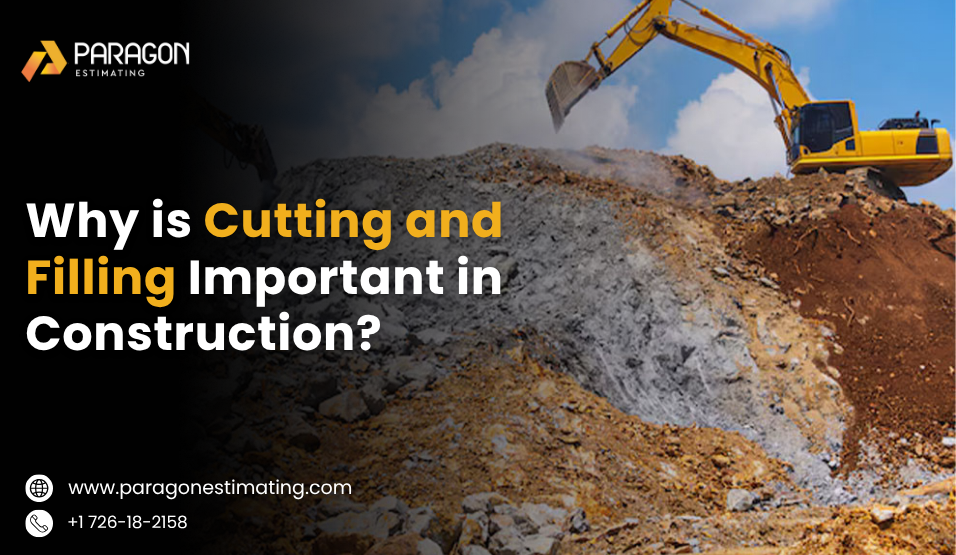Introduction to Cutting and Filling for Earthwork
If you can imagine a building project taking shape, whether it is an expansive residential community, a commercial plaza, or a towering building, the first and most vital step involves preparing the ground. Before laying concrete or erecting steel, the site must be leveled, shaped, and prepared. The field of shaping and filling earthwork refers to this crucial step.
We are at Paragon Estimating, understanding the importance of accurate earthwork calculations. In this article, we will show you the importance of the cutting and filling process in construction, as well as how our expert cost estimating services can help you save time and money and reduce hassles on your next project.

What is Cutting and Filling for Earthwork?
In the construction industry, cutting and filling earthwork is the process of shaping land by making cuts (e.g., excavating) in earth from higher ground and filling (adding) it to lower ground to form an even surface. This method ensures that a site is sound structurally and is suitable for the use of the building.
- This process involves removing dirt or rocks from high areas, which is often referred to as digging.
- Filling Removal of excavated material to lower areas so that they can be raised to the desired height.
The two processes are complementary and help to balance the soil levels and prevent over-export or import of material, thus maximizing the environmental and cost impact.
Why is Cutting and Filling Important in Construction?
Let’s say you’re planning to build a home on an uneven piece of land. If you don’t level it properly, the building could be prone to foundation problems and drainage issues. It could collapse in the most extreme instances. cutting and filling for earthwork guarantees:
- Stable foundation
- Efficient water drainage
- Security for structures and their occupants
- Conformity to engineering standards
- Cost-effective site preparation
It’s an integral element of the preparation of the ground for construction, regardless of whether you’re constructing roadways, residential plots, or burial areas.
Types of Earthwork in Construction Projects
Earthwork doesn’t only involve shifting soil. It encompasses a range of methods based on the conditions of the soil, along with the project’s type and the site’s design. The most important categories are
Hairline Cutting
It involves excavating the higher portions of the construction site. It may involve removing soil, rocks, or old construction debris.
Common applications
- The construction of roads
- Foundation pits
- Basement creation
- Hill slope reduction
Filling
Excavating soil or imported material to fill in depressions and low-lying areas accomplishes this.
Common applications
- Raising site levels
- Backfilling the foundations
- Embanking embankments
Combined Cutting and Filling
A site usually requires two processes to create an equal, level platform. This is known as cutting earthwork.
Step-by-Step Process of Cutting and Filling for Earthwork
Site Survey and Design
Before beginning any ground cutting, we initiate the survey and conduct a site assessment to evaluate the terrain. Then, engineers develop the new levels, taking into account the needs of the project.
Earthwork Calculation and Estimation
A precise estimation will ensure control of costs and management of materials. The Construction Estimating Services are experts in providing accurate earthwork quantity estimates, as well as estimates for cutting and filling.
Preparation
Cutting and filling zones are identified on-site. Heavy machinery, like bulldozers and excavators, as well as excavators, is moved. graders,
Execution of Ground Cutting
Land that is elevated is cut until the desired level. We either store the removed soil or rock or directly transfer it to areas for filling.
Filling and Compaction
We then place the cut material in low-lying areas. We then compact the material layer by layer to achieve the desired density and stability.
Final Grading
After cutting and filling for earthwork is completed, the site is then subjected to final grading to ensure the proper slope.
Common Challenges in Cutting and Filling For Earthwork
While it might sound easy, cutting and filling for earthwork are not without challenges.
- Inexpensive soil condition
- The terrain is rocky and requires blasting.
- Blasting eruptions in the weather
- Material surplus or shortage
- Environmental rules
We are Paragon Estimating. Managers of projects reduce these risks by offering professional earthwork estimations along with proactive
Tools and Equipment Used for Ground Cutting and Filling
The type of machine you choose will depend on the area’s size and the type of material. The tools most commonly used are
Ground Cutting
- Excavators
- Rock breakers
- Bulldozers
For Filling
- Dump trucks
- Backhoes
- Rollers
Browse the range of Construction Equipment Estimation Services for more detailed breakdowns of the cost of equipment.
Benefits of Accurate Cutting and Filling Estimation
Making the wrong cutting and filling for earthwork quantities incorrectly can result in expensive rework, project delays, and budget overruns. Accurate cost estimation ensures:
- Cost control
- Material optimization
- Time management
- Safety conformity
Our experienced estimators at Paragon Estimating provide accurate and reliable estimates specifically tailored to your project.
Contact us to request a free estimate on earthwork.
How Paragon Estimating Can Help You
Paragon Estimating, one of the most trusted businesses, can provide:
- Complete earthwork quantity take-offs
- Trim and fill balance reports
- Calculation of the cost of cutting, filling, and compacting
- Analysis of soils specific to the site
No matter if you’re a general contractor, engineer, or property developer, not all your ground preparation requirements are covered for you.

Why Cutting and Filling is Essential
A construction project will not be successful without the proper preparation of the ground. Cutting earthwork involves more than just moving dirt; it also involves maintaining structural stability and ensuring the project’s efficiency. With accurate estimates, intelligent planning, and professional execution, you’ll be able to reduce the cost by thousands and prevent setbacks during construction. In Paragon Estimating, we provide expert estimates of the earthwork, aiding contractors, developers, engineers, and builders to manage the preparation of sites quickly and effectively.
Ready to Get Your Earthwork Estimate?
Don’t make costly mistakes or delays. Request a cutting and filling estimate now! Request a Free Earthwork Estimation.
FAQs
What’s the point of filling and cutting?
Create a level surface to build on by reducing elevated areas and filling them with low-lying areas.
How do you determine the quantity of cutting and filling?
We use comprehensive topographic surveys and volume calculation formulas. In Paragon Estimating, we employ the most advanced software as well as manual verification.
What tools are used to cut earthwork?
Typically, bulldozers, excavators, dump trucks, and rollers are utilized.
Does cutting and filling alter soil stability?
Yes. This is why compaction and a proper drainage design are crucial components of the entire process.
What are the costs associated with the cutting and filling processes?
Costs are based on the conditions of the site, the soil type, the site’s condition, and the volume. Contact Paragon Estimating for a customized earthwork estimate.


